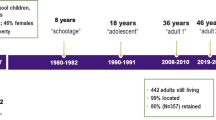Abstract
Childhood maltreatment, witnessing violence, and growing up with absent, addicted, or mentally ill caregivers influence adult physical and psychological well-being and may play an important role in female offending. This study utilizes data from a study of 60 incarcerated women to examine a possible intervening variable in the victimization-crime relationship. We conduct qualitative analyses to examine family influences on substance use among female offenders. Findings indicate that substance use may arise from a need to cope with child victimization and adversity, and that factors such as poor parental supervision may contribute to girls’ substance use. After onset of drug use, many women may turn to further criminal activity to support their habits. Implications for research and intervention are addressed.
Similar content being viewed by others
References
Bahr, S., Maughan, S., Marcos, A., & Li, B. (1998). Family, religiosity, and the risk of adolescent drug use. Journal of Marriage and Family, 60(1), 979–992.
Belknap, J., & Holsinger, K. (2006). The gendered nature of risk factors for delinquency. Feminist Criminology, 1(1), 48–71.
Browne, A., Miller, B., & Maguin, E. (1999). Prevalence and severity of lifetime physical and sexual victimization among incarcerated women. International Journal of Law and Psychiatry, 22(3–4), 301–322.
Chesney-Lind, M., & Rodriguez, N. (1983). Women under lock and key: a view from the inside. The Prison Journal, 63(2), 47–65.
Cincom Systems (2012). Atlas.ti software, Version 6.2. Berlin, Germany.
IBM Corporation (2010). SPSS Statistics, Version 19. IBM Global.
DeHart, D. (2008). Pathways to prison: impact of victimization in the lives of incarcerated women. Violence Against Women, 14(12), 1362–1381.
DeHart, D. (2009). Polyvictimization among girls in the juvenile justice system: manifestations and associations to delinquency (NCJRS Document #228620). Columbia: The Center for Child & Family Studies, College of Social Work, University of South Carolina.
Edmund, D., & Bland, P. (2011). Real tools: responding to multi-abuse trauma—a tool kit to help advocates and community partners better serve people with multiple issues. Juneau: Alaska Network on Domestic Violence & Sexual Assault.
Emerson, R., Fretz, R., & Shaw, L. (1995). Writing ethnographic fieldnotes. Chicago: University of Chicago.
Fagan, A. (2001). The gender cycle of violence: comparing the effects of child abuse and neglect on criminal offending for males and females. Violence and Victims, 16(4), 457–474.
Felitti, V. (2003). Origins of addictive behavior: evidence from the ACE Study. PMID: 14619682. Accessed online March 22, 2011 at www.acestudy.org.
Gilfus, M. (1992). From victims to survivors to offenders: women’s routes of entry and immersion into street crime. Women and Criminal Justice, 4(1), 63–89.
Jennings, A. (2011). Models for developing trauma-informed behavioral health systems and trauma-specific services: an update of the 2004 report. Washington, DC: United States Department of Health and Human Services.
Kiesner, J., Poulin, F., & Dishion, T. (2010). Adolescent substance use with friends: moderating and mediating effects of parental monitoring and peer activity contexts. Merrill-Palmer Quarterly, 56(4), 529–556.
Mounts, N. S., & Steinberg, L. (1995). An ecological analysis of peer influence on adolescent grade-point-average and drug use. Developmental Psychology, 31(1), 915–922.
Richie, B. (1996). Compelled to crime: the gender entrapment of battered black women. New York: Routledge.
Salisbury, E., & Van Voorhis, P. (2009). Gendered pathways: a quantitative investigation of women probationers’ paths to incarceration. Criminal Justice and Behavior, 36(6), 541–566.
Schaffner, L. (2006). Girls in trouble with the law. New Brunswick: Rutgers.
Strauss, A. (1987). Qualitative analysis for social scientists. Cambridge: Cambridge University.
Turner, H., Finkelhor, D., & Ormrod, R. (2006). The effect of lifetime victimization on the mental health of children and adolescents. Social Science & Medicine, 62(1), 13–27.
Turner, R. J., & Lloyd, D. (1995). Lifetime traumas and mental health: the significance of cumulative adversity. Journal of Health and Social Behavior, 36, 360–376.
Zahn, M., Agnew, R., Fishbein, D., Miller, S., Winn, D., Dakoff, G., & Chesney-Lind, M. (2010). Girls Study Group: understanding and responding to girls’ delinquency. Washington, DC: United States Department of Justice.
Author information
Authors and Affiliations
Corresponding author
Additional information
Melissa Bowles is in the Department of Criminology and Criminal Justice at the University of South Carolina, Columbia, SC 29208; both Dana DeHart and Jennifer Reid Webb are with The Center for Child and Family Studies, College of Social Work, University of South Carolina, Columbia, SC 29208.
This Project was supported by Grant No. #2000-WT-VX-0010 awarded by the National Institute of Justice, Office of Justice Programs, U.S. Department of Justice. Points of view in this document are those of the author and do not necessarily represent the official position or policies of the U.S. Department of Justice.
Rights and permissions
About this article
Cite this article
Bowles, M.A., DeHart, D. & Webb, J.R. Family Influences on Female Offenders’ Substance Use: The Role of Adverse Childhood Events among Incarcerated Women. J Fam Viol 27, 681–686 (2012). https://doi.org/10.1007/s10896-012-9450-4
Published:
Issue Date:
DOI: https://doi.org/10.1007/s10896-012-9450-4




